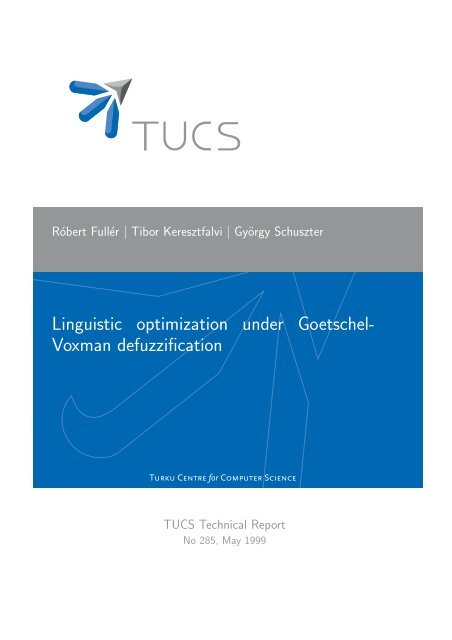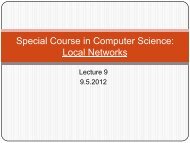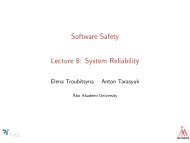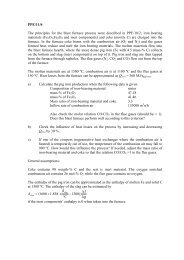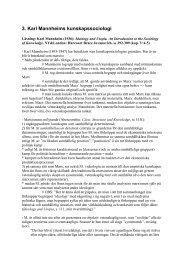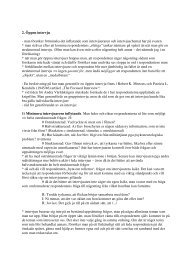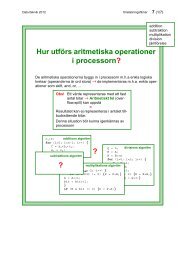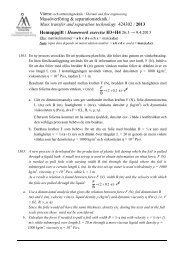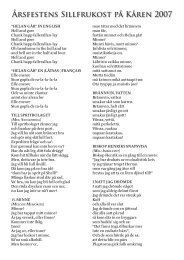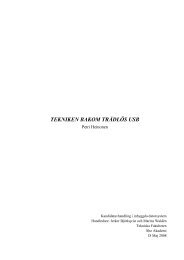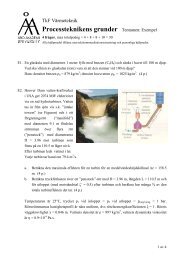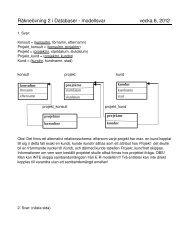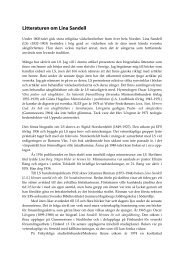Linguistic optimization under Goetschel- Voxman ... - Åbo Akademi
Linguistic optimization under Goetschel- Voxman ... - Åbo Akademi
Linguistic optimization under Goetschel- Voxman ... - Åbo Akademi
Create successful ePaper yourself
Turn your PDF publications into a flip-book with our unique Google optimized e-Paper software.
Róbert Fullér | Tibor Keresztfalvi | György Schuszter<br />
<strong>Linguistic</strong> <strong>optimization</strong> <strong>under</strong> <strong>Goetschel</strong>-<br />
<strong>Voxman</strong> defuzzification<br />
TUCS Technical Report<br />
No 285, May 1999
<strong>Linguistic</strong> <strong>optimization</strong> <strong>under</strong> <strong>Goetschel</strong>-<br />
<strong>Voxman</strong> defuzzification<br />
Róbert Fullér<br />
Eötvös L. University, Department of Operations Research,<br />
Múzeum krt. 6-8, H–1088 Budpaest, Hungary<br />
Tibor Keresztfalvi<br />
Eötvös L. University, Department of Applied Analysis,<br />
Múzeum krt. 6-8, H–1088 Budpaest, Hungary<br />
*Supported by the Bolyai scholarship of the<br />
Hungarian Academy of Sciences<br />
György Schuszter<br />
Kandó K. College of Engineering,<br />
Institute of Instrumentation and Automation,<br />
Tavaszmező u. 15-17, H–1084 Budpaest, Hungary<br />
TUCS Technical Report<br />
No 285, May 1999
Abstract<br />
We consider <strong>optimization</strong> problems in which the relation between the objective<br />
function and the decision variables is not known exactly but described<br />
linguistically and represented in form of fuzzy if-then rules. To deal with linguistic<br />
variables represented by fuzzy sets with non-monotonic membership<br />
functions, we suggest replacing Tsukamoto’s fuzzy reasoning method with another<br />
one based on <strong>Goetschel</strong>-<strong>Voxman</strong> defuzzification and give an alternative<br />
procedure to obtain the crisp relationship between the objective function and<br />
the decision variables. An optimal solution to the original fuzzy <strong>optimization</strong><br />
problem can be then obtained by solving the resulting crisp mathematical<br />
programming program. We also give an example of the proposed procedure.<br />
Keywords: Defuzzification, fuzzy <strong>optimization</strong>, linguistic variables, if-then<br />
rules
1 Introduction<br />
Let us consider the <strong>optimization</strong> problem of the form<br />
max/minf(x); subject to x ∈ X ⊂ R n ,<br />
where f(x) is not known exactly for any x ∈ X but the causal link between<br />
x and f(x) is described linguistically using fuzzy if-then rules. According to<br />
[2], we can write our problem in the following form:<br />
with<br />
max/min f(x); subject to {R1(x), . . .,Rm(x) | x ∈ X ⊂ R n }, (1)<br />
Ri(x): if x1 is Ai1 and ... and xn is Ain then f(x) is Ci,<br />
where Aij and Ci (i = 1, . . .,m, j = 1, . . .,n) are fuzzy numbers. We want<br />
to find crisp values x ∈ X that minimize/maximize f(x) in certain sense.<br />
One can find a number of solution procedures for this kind of problems<br />
proposed e.g. in [1]. Let us recall the one which is based on Tsukamoto’s<br />
fuzzy reasoning method [5] and suggests determining the crisp value f(u)<br />
corresponding to the crisp input u = (u1, . . .,un) ∈ X as follows:<br />
1. Calculate the firing levels of individual rules by the product t-norm:<br />
λi := Ai1(u1) · . . . · Ain(un) (i = 1, . . ., m).<br />
2. Take the crisp rule output for each if-then rule:<br />
zi := C −1<br />
i (λi) (i = 1, . . ., m).<br />
3. Aggregate the individual inputs by finding their weighted average (where<br />
the associated weights are the calculated firing levels, respectively) and<br />
get the overall system output:<br />
z := λ1z1 + . . . + λmzm<br />
.<br />
λ1 + . . . + λm<br />
In this wise, our original <strong>optimization</strong> problem (1) turns into the following<br />
crisp mathematical programming problem:<br />
max/minf(u); subject to u ∈ X ⊂ R n .<br />
We would like to point out that Tsukamoto’s fuzzy reasoning method<br />
(specifically its second step) assumes that the conclusion part of each if-then<br />
rule Ri is described by a fuzzy set Ci having strictly monotonic membership<br />
1
function. On the other hand, the overall system output is calculated as the<br />
weighted average of the individual rule outputs, which is actually the discrete<br />
Center-of-Gravity of these outputs.<br />
In this paper we suggest applying the Center-of-Gravity method also in<br />
the second step of the procedure described above. This will allow our rule<br />
base to contain also if-then rules with conclusion parts having not necessarily<br />
monotonic membership functions.<br />
2 <strong>Goetschel</strong>-<strong>Voxman</strong> defuzzification of<br />
fuzzy intervals<br />
We will represent the conclusion part of the if-then rules by fuzzy intervals<br />
having trapezoidal membership functions:<br />
⎧<br />
a − x<br />
1 − if x ∈ [a − α, a]<br />
⎪⎨<br />
α<br />
1 if x ∈ [a, b]<br />
C(x) := (a, b, α, β)(x) := x − b<br />
(2)<br />
1 − if x ∈ [b, b + β]<br />
⎪⎩<br />
β<br />
0 otherwise<br />
For us, it is more convenient now to describe a fuzzy interval with its level<br />
sets:<br />
[C] γ := {x ∈ R | C(x) ≥ γ} (0 < γ ≤ 1)<br />
and [C] 0 := supp C. Obviously, the level sets of fuzzy intervals are always<br />
crisp intervals. It is also easy to verify that by introducing the notations<br />
a(γ) := min[C] γ , b(γ) := max[C] γ ,<br />
we can describe the fuzzy interval (2) with its level sets as follows:<br />
[C] γ = [a(γ), b(γ)] = [a − (1 − γ)α , b + (1 − γ)β] (0 < γ ≤ 1).<br />
The <strong>Goetschel</strong>-<strong>Voxman</strong> defuzzification method [3] defines the crisp value corresponding<br />
to a fuzzy interval as the weighted average of the centers of γ-level<br />
sets. For the fuzzy interval C we have:<br />
GW(C) =<br />
� 1<br />
0<br />
a(γ) + b(γ)<br />
γ · dγ<br />
2<br />
� 1 , (3)<br />
γ dγ<br />
i.e. the weight of the center of [C] γ is just γ. After some calculation, we can<br />
easily obtain the following expression:<br />
GW(C) = GW((a, b, α, β)) =<br />
2<br />
0<br />
a + b<br />
2<br />
β − α<br />
+ . (4)<br />
6
It is clear that by shearing a trapezoidal fuzzy interval at a certain (firing)<br />
level λ ∈ [0, 1], the remaining part will also be of trapezoidal shape. The<br />
sheared fuzzy interval Cλ is not normed to 1 anymore, see Figure 1. For its<br />
level sets we have simply<br />
[Cλ] γ =<br />
� [C] γ<br />
if 0 ≤ γ ≤ λ,<br />
∅ if λ < γ.<br />
According to this, the expression (3) must be slightly modified for Cλ as<br />
follows:<br />
� λ<br />
a(γ) + b(γ)<br />
γ · dγ<br />
0 2<br />
GW(Cλ) =<br />
. (5)<br />
This can easily be reduced to the form<br />
GW(Cλ) = GW((a, b, α, β)λ) =<br />
� λ<br />
0<br />
γ dγ<br />
a + b<br />
2<br />
+ β − α<br />
6<br />
which of course coincides with (4) if we substitute λ = 1.<br />
1<br />
C<br />
λ<br />
✲<br />
✁<br />
a−α a b b+β<br />
✁✁✁<br />
❩<br />
❩❩❩❩❩<br />
3 Special cases<br />
1<br />
λ Cλ<br />
✁ ✁<br />
❩<br />
❩❩<br />
Figure 1: Sheared fuzzy interval<br />
(3 − 2λ), (6)<br />
In most cases (in order to meet the requirements of Tsukamoto’s fuzzy reasoning<br />
method) rule bases consist of fuzzy if-then rules with conclusion parts<br />
having skewed triangular shape, that is a zero-width peak and zero left or<br />
right spreads, see Figure 2. Our expression (4) for these special cases reduces<br />
to the following form:<br />
GW((a, a, α, 0)) = a − α<br />
6 ,<br />
GW((b, b, 0, β)) = b + β<br />
6 .<br />
3
Shearing these skewed triangular fuzzy sets at level λ ∈ [0, 1] results in<br />
trapezoidal fuzzy intervals with one of the spreads being equal to zero. It is<br />
easy to verify that in these cases the Center-of-Gravity reads as follows:<br />
4 Example<br />
3 − 2λ<br />
GW((a, a, α, 0)λ) = a − α,<br />
6<br />
(7)<br />
3 − 2λ<br />
GW((b, b, 0, β)λ) = b + β.<br />
6<br />
(8)<br />
Let us take a particular example from [2] with two decision variables x1 and<br />
x2 and consider the following <strong>optimization</strong> problem:<br />
min f(x1, x2); subject to {x1 + x2 = 1/2, (x1, x2) ∈ [0, 1] 2 ⊂ R 2 }, (9)<br />
where the correspondence (x1, x2) ↦→ f(x1, x2) is given linguistically as<br />
R1(x1, x2): if x1 is small and x2 is small then f(x1, x2) is small,<br />
R2(x1, x2): if x1 is small and x2 is big then f(x1, x2) is big,<br />
and the linguistic values small and big are described with skewed triangular<br />
fuzzy numbers:<br />
see Figure 2.<br />
1<br />
small = (0, 0, 0, 1), big = (1, 1, 1, 0),<br />
❍ ❍❍❍❍❍❍❍<br />
small<br />
0 1<br />
big<br />
✟<br />
0 1<br />
✟✟✟✟✟✟✟<br />
Figure 2: Skewed fuzzy intervals<br />
Let us take an arbitrary crisp input (u1, u2) and follow the solution procedure<br />
described in the introduction but applying the <strong>Goetschel</strong>-<strong>Voxman</strong><br />
defuzzification method in the second step:<br />
1. The firing levels are obviously<br />
λ1 = (1 − u1)(1 − u2), λ2 = (1 − u1)u2. (10)<br />
4<br />
1
2. We defined individual rule outputs as the Center-of-Gravity of sheared<br />
fuzzy intervals and calculate them according to (7) and (8):<br />
3 − 2λ1<br />
z1 = GW((0, 0, 0, 1)λ1) =<br />
6<br />
3 − 2λ2<br />
z2 = GW((1, 1, 1, 0)λ2) = 1 −<br />
6<br />
3. We obtain f(u1, u2) as the weighted average of z1 and z2 with weights<br />
λ1 and λ2, respectively:<br />
f(u1, u2) =<br />
3−2λ1<br />
λ1 + (1 − 6 3−2λ2)<br />
λ2 6<br />
λ1 + λ2<br />
i.e. after substituting (10) in this expression we get:<br />
f(u1, u2) = 3 − 2(1 − u1)(1 − u2)<br />
(1 − u2) +<br />
6<br />
�<br />
�<br />
3 − 2(1 − u1)u2<br />
+ 1 − u2 =<br />
6<br />
= 1 1<br />
−<br />
2 3 (1 − u1)(1 − 2u2).<br />
Thus, we converted our initial fuzzy <strong>optimization</strong> problem into the following<br />
crisp mathematical programming problem:<br />
subject to<br />
f(u1, u2) → min<br />
u1 + u2 = 1/2, (u1, u2) ∈ [0, 1] 2 ⊂ R 2 .<br />
,<br />
(11)<br />
Introducing the notation t := u1 and taking into account that u2 = 1/2 − t,<br />
we have after some reduction the equivalent problem<br />
f(t) = 1 1<br />
+<br />
3 6 (2t − 1)2 → min, t ∈ [0, 1/2],<br />
which has the optimal solution t ∗ = 1/2, that is<br />
and the optimal value is<br />
u ∗ 1 = 1/2, u∗ 2<br />
= 0<br />
f(u ∗ ) = f(u ∗ 1, u ∗ 2) = 1/3.<br />
Firstly, we should note that this solution differs from that obtained in<br />
[2] (u ∗ 1 = u ∗ 2 = 1/4, f(u ∗ ) = 3/8). However, it reflects more fairly the fact<br />
5
included in the rule base implicitly, namely that f(x) = f(x1, x2) actually<br />
depends just on (and correlates just with) x2. We should also mention that<br />
the optimal value f(u ∗ ) is calculated else-ways in [2]. We can compare the<br />
optimal values if we evaluate (11) for the input variables (u1, u2) = (1/4, 1/4):<br />
f(1/4, 1/4) = 3/8 = 0.375 > 1/3 ≈ 0.33.<br />
On the other hand, this solution completely coincides with that obtained<br />
in [4] where the Center-of-Gravity defuzzification was involved instead of the<br />
<strong>Goetschel</strong>-<strong>Voxman</strong> method.<br />
References<br />
[1] C. Carlsson and R. Fullér, Optimization <strong>under</strong> fuzzy if-then rules, Fuzzy<br />
Sets and Systems (1999) (to appear).<br />
[2] R. Fullér, Fuzzy Reasoning and Fuzzy Optimization (TUCS General Publication,<br />
Turku, 1998).<br />
[3] R. <strong>Goetschel</strong> and W. <strong>Voxman</strong>, Topological properties of fuzzy numbers,<br />
Fuzzy Sets and Systems 9 (1983) 87–99.<br />
[4] T. Keresztfalvi, Optimization with linguistic variables using the Centerof-Gravity<br />
defuzzification, in: C. Carlsson and R. Fullér eds., Frontiers<br />
in Soft Decision Analysis, Studies in Fuzziness (Physica-Verlag, Heidelberg,<br />
1999, to appear).<br />
[5] Y. Tsukamoto, An approach to fuzzy reasoning method, in: M. M.<br />
Gupta, R. K. Ragade and R. R. Yager eds., Advances in Fuzzy Set<br />
Theory an Applications (North-Holland, New York, 1979).<br />
6
Lemminkäisenkatu 14 A, 20520 Turku, Finland | www.tucs.fi
ISBN 952-12-0475-3<br />
ISSN 1239-1891<br />
University of Turku<br />
• Department of Information Technology<br />
• Department of Mathematics<br />
˚Abo <strong>Akademi</strong> University<br />
• Department of Computer Science<br />
• Institute for Advanced Management Systems Research<br />
Turku School of Economics and Business Administration<br />
• Institute of Information Systems Sciences


